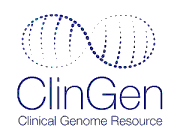Adult Summary Report Secondary Findings in Adult Subjects Non-diagnostic, excludes newborn screening & prenatal testing/screening Permalink A Current Version Rule-Out Dashboard Release History Status (Adult): Passed (Consensus scoring is Complete) Curation Status (Adult): Released 1.0.1
GENE/GENE PANEL:
PMP22
Condition:
Hereditary Neuropathy with Liability to Pressure Palsies
Mode(s) of Inheritance:
Autosomal Dominant
Actionability Assertion
Gene Condition Pairs(s)
Final Assertion
PMP22⇔162500
Assertion Pending
Actionability Rationale
This topic was initially scored prior to development of the process for making actionability assertions. The Actionability Working Group decided to defer making an assertion until after the topic could be reviewed through the update process.
Final Consensus Scoresa
Outcome / Intervention Pair
Severity
Likelihood
Effectiveness
Nature of the
Intervention
Intervention
Total
Score
Score
Neuropathy / Avoidance of triggers
1
3C
1C
3
8CC
a.
To see the scoring key, please go to : https://www.clinicalgenome.org/site/assets/files/2180/actionability_sq_metric.png
Topic
Narrative Description of Evidence
Ref
1. What is the nature of the threat to health for an individual carrying a deleterious allele?
Prevalence of the Genetic Condition
Clinical Features
(Signs / symptoms)
(Signs / symptoms)
HNLPP is characterized by episodic focal motor and sensory peripheral neuropathies. These attacks are painless and may be episodic. In many cases these symptoms are triggered by mechanical stresses to the nerve, such as compression, repetitive movement and/or stretching of the affected limbs. Common clinical manifestations include carpal tunnel syndrome and peroneal palsy with foot drop. In 50% of cases, recovery from the acute neuropathy is complete within a few days to months. Incomplete recovery is common, though the resulting disability rarely severe. Chronic motor deficits after nerve palsies are noted in 10-15%. In rare cases, strenuous activities can lead to severe and prolonged limb paralysis.
Natural History
(Important subgroups & survival / recovery)
(Important subgroups & survival / recovery)
Most individuals with HNLPP typically experience their first episode in the second or third decade at a mean age of 37 years, but with a large range from birth through the eighth decade. The most common presenting symptom is acute onset of a focal neuropathy of a single nerve (mononeuropathy). Males and females are equally affected, though occasional episodes have been reported during pregnancy, likely related to physiological changes. Older patients often develop a symmetric sensory motor polyneuropathy. HNLPP is not life threatening, and patients have a normal life expectancy.
2. How effective are interventions for preventing harm?
Information on the effectiveness of the recommendations below was not provided unless otherwise stated.
Information on the effectiveness of the recommendations below was not provided unless otherwise stated.
Patient Management
Surveillance
No surveillance recommendations have been provided for the Adult context.
Circumstances to Avoid
Information on the effectiveness of these interventions was not provided. Patients are advised to avoid prolonged sitting with legs crossed, prolonged leaning on the elbows, occupations requiring repetitive movements of the wrist, and rapid weight loss.
(Tier 3)
3. What is the chance that this threat will materialize?
Mode of Inheritance
Autosomal Dominant
Prevalence of Genetic Variants
Penetrance
(Include any high risk racial or ethnic subgroups)
(Include any high risk racial or ethnic subgroups)
The penetrance of PMP22 mutations for HNLPP phenotypes is unknown, though it is likely incomplete as some individuals carrying a disease-causing mutation are asymptomatic.
(Tier 4)
Other evidence for incomplete penetrance may be derived from studies which have found the percentages of asymptomatic family members of index patients varied from 6-23%.
(Tier 3)
Information on the penetrance of variants was not available for the Adult context.
Relative Risk
(Include any high risk racial or ethnic subgroups)
(Include any high risk racial or ethnic subgroups)
Information regarding relative risk was unavailable.
Expressivity
4. What is the Nature of the Intervention?
Nature of Intervention
The intervention identified in this report (wearing protective pads) is of low risk and intensity.
5. Would the underlying risk or condition escape detection prior to harm in the setting of recommended care?
Description of sources of evidence:
Tier 1: Evidence from a systematic review, or a meta-analysis or clinical practice guideline clearly based on a systematic review.
Tier 2: Evidence from clinical practice guidelines or broad-based expert consensus with non-systematic evidence review.
Tier 3: Evidence from another source with non-systematic review of evidence with primary literature cited.
Tier 4: Evidence from another source with non-systematic review of evidence with no citations to primary data sources.
Tier 5: Evidence from a non-systematically identified source.
Date of Search:
05.13.2014
Reference List
1.
Hereditary Neuropathy with Liability to Pressure Palsies.
1998 Sep 28
[Updated 2014 Sep 25].
In: RA Pagon, MP Adam, HH Ardinger, et al., editors.
GeneReviews® [Internet]. Seattle (WA): University of Washington, Seattle; 1993-2025.
Available from: http://www.ncbi.nlm.nih.gov/books/NBK1392
2.
Hereditary neuropathy with liability to pressure palsies.
Orphanet encyclopedia,
http://www.orpha.net/consor/cgi-bin/OC_Exp.php?lng=en&Expert=640
